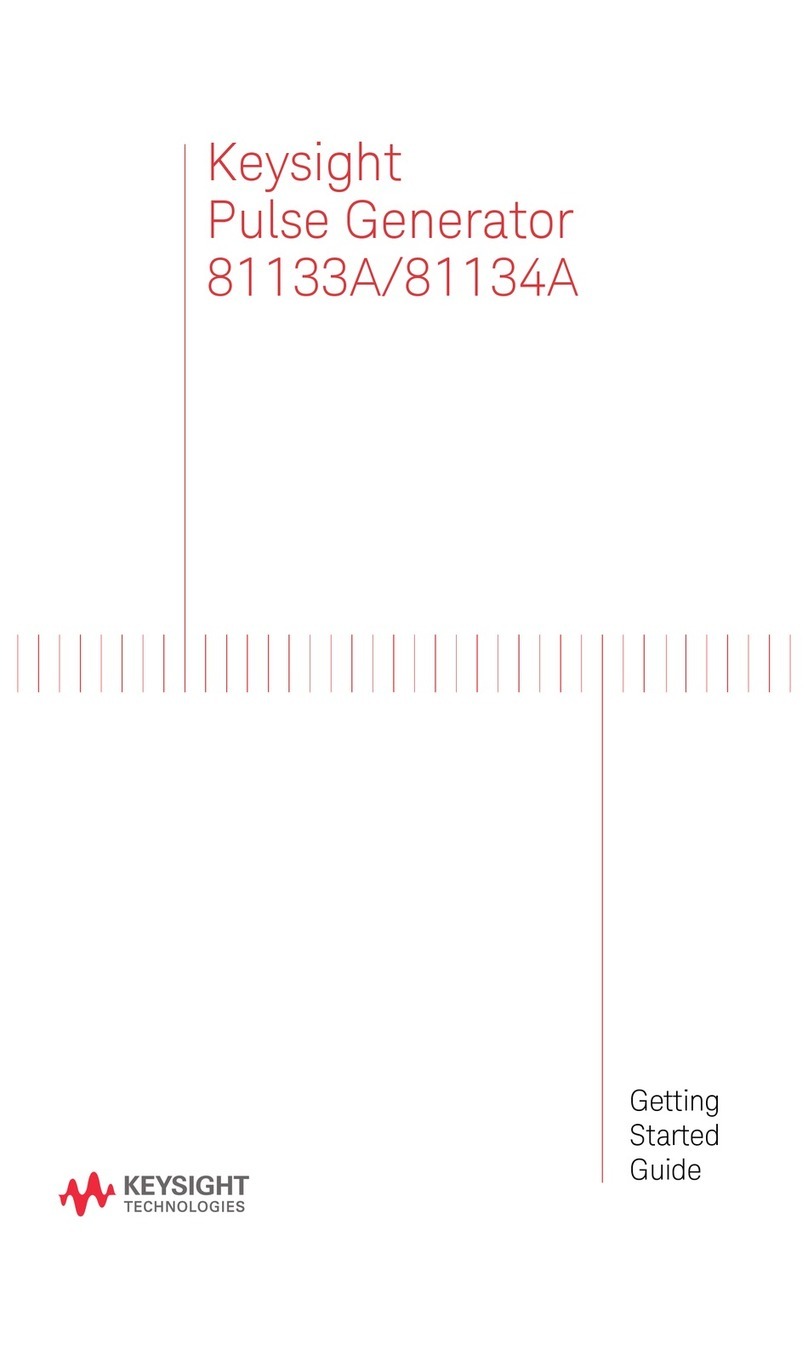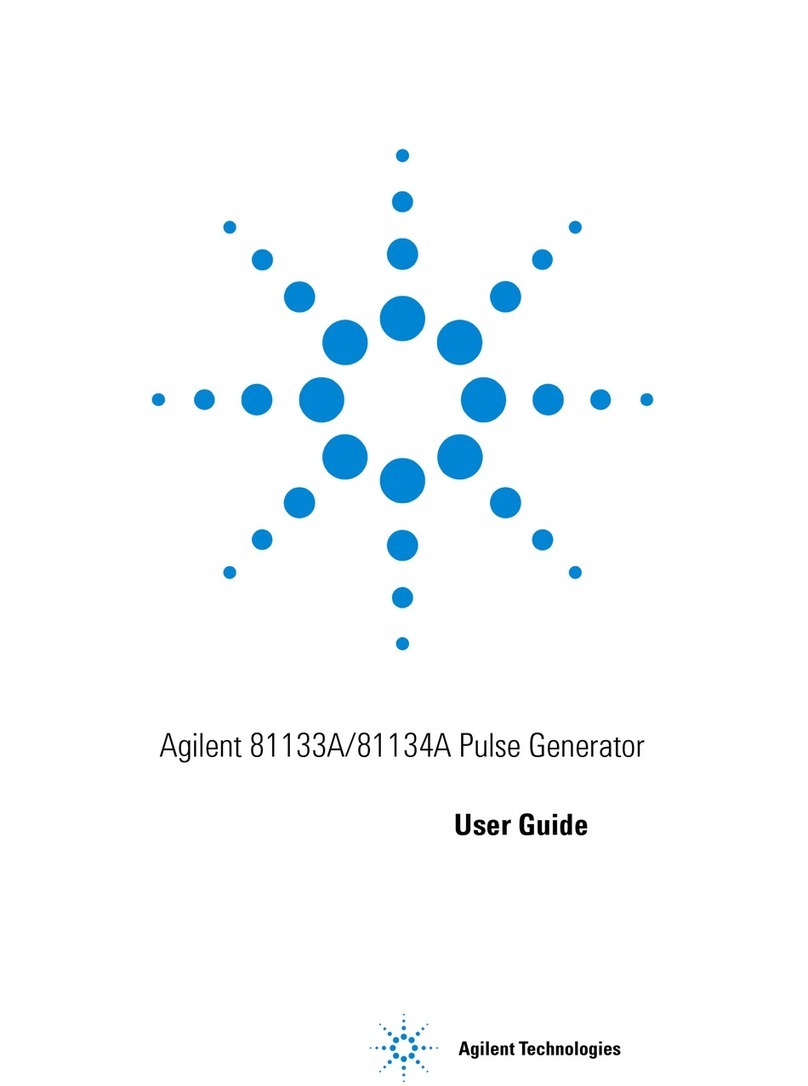Datapulse 101 Manual



SECTION
1
SPECIFICATIONS
l.
1
GENERAL
INFORMATION
The
Datapulse
Model
101
is
an
unusually
compact
high
performance
and
low
cost
pulse
generator.
Unique
circuit
design
utilizing
a
minimum
of
advanced
solid
state
components,
sets
new
standards
for
pulse
generator
reliability
and
economy
and
extends
versatility.
The
instrument
is
designed
for
a
wide
spectrum
of
pulse
testing,
circuit
development
and
general
laboratory
applications.
Its
capabilities
include
simultaneous
positive
and
negative
variable
amplitude
outputs;
single
or
double
pulse
operation;
internal
or
external
triggering;
synchronous
or
asynchronous
gating;
and
internal
or
external
sine
wave
triggering.
Each
of
the
two
outputs
deliver
2
watts
into
50
ohm
loads.
All
operating
controls
and
test
connectors
are
on
the front
panel
except
the
115-230
line
voltage
selector
switch
which
is
on
the
back.
1.2
REPETITION
RATE
The
repetition
rate
is
continuously variable
from
10
Hz
to
10
MHz
by
means
of
a six
step
decade
selector
switch
and
a
fill-in
vernier
control
for
either
single
or
double
pulse
operation.
Effective
repetition
rates
to
20
MHz
may
be
set
up
in
the
double
pulse
mode
by
proper
positioning
of
the
second
pulse.
1.
3
EXTERNAL
TRIGGER
Reliable
triggering
at
any
point
on
the
input
waveform
between
0.
25
volts
and
5
volts
above
(or
below)
its
average
dc
level
for
positive
(or
negative)
going
waveforms
with
a
minimum
duration
of
30
nanoseconds
at
frequencies
from
0
to
10
MHz
is
obtained
by
proper
selection
of
slope
polarity
and
level
controls.
Sine
wave
signals
above
1
volt
rms
at
frequencies
of
50
Hz
to
10
MHz
may
be
used
for
external
triggering.
The
input
impedance
is
greater
than
2.
5k
ohms
and
the
maximum
transient
amplitude
which
may
be
applied
is
:5
volts.
1.4
LINE
VOLTAGE
TRIGGER
The
unit
may
be
triggered
from
any
point
on
the
positive
or
negative
slope
of
the
ac
line
voltage
waveform
for either
internal
or
external
(see
1. 3
above)
operation.
In
both
cases
the
trigger
point
is
determined
by
the setting
of
the
slope
level
control.
The
trigger
signal
is
supplied
by
the
power
trans—
former
secondary
for
internal
operation.
To
simulate
triggering
on
the
crest

of
the
sine
wave
where
the
rise
time
is
less
than
the
minimum
required,
it
is
necessary
to
incorporate
a
suitable
pulse
delay
setting.
1.
5
SINGLE
PULSE
The
instrument
may
be
triggered
manually
by
a
pushbutton
for
one
cycle
(single
or
double
pulse)
of
output.
1.
6
GATED
OPERATION
External
gate
signal
levels
more
positive
than
+1
volt
are
required
to
enable
the
main
pulse
outputs
for
either
synchronously
or
asynchronously
gated
modes.
Levels
greater
than
10
volts
may
not
be
applied.
1.
6.
l
Synchronous
Gating
The
repetition
rate
generator
circuit
is
disabled
in
this
mode
of
operation
until
the
unit
receives
an
external
gating
signal.
The
generator
turns
off
again
when
the
signal
is
removed.
This
synchronizes
the
first
main
pulse
of
the
gated
burst
to
the
leading
edge
of
the
gating
signal
and
stops
the
pulse
train
when
the
signal
turns
off.
Both
trigger
outputs
are
also
gated.
l.
6.
2
Asynchronous
Gating
In
this
mode,
the
time
delay
circuit
is
disabled
while
the
repetition
rate
generator
operates
continuously.
Both
the
main
pulse
output
and
the
reference
trigger
begin
with
the
first
cycle
occurring
after
the application
of
the
gate
for
either
external or
internal
triggering.
The
advanced
trigger
output
is
not
gated
and
is
available
as a
clock
pulse
on
internally
triggered
operations
.
1.
6.
3
Coincidence
Gating
This
mode
of
operation
is
achieved
by
combining
external
gating
with
external
triggering
so
that
the
main
pulse
outputs
occur
only
when
the
two
are
coincident.
l.
7
TRIGGER
OUTPUTS
The
trigger
outputs
are
positive
with
an
amplitude
of
2
volts
from
a
50
ohm
source
impedance
and
a
duration
of
approximately
50
nanoseconds.
1.
7.1
Advance
Trigger
This
trigger
is
available
on
internally
triggered
operations
only
and
occurs
approximately
10
percent
of
the
repetition
rate
period before
the
reference
trigger.
1.
7.
2
Reference
Trigger
The
reference
trigger
occurs
approximately
30
nanoseconds
after
1-2

the
unit
is
triggered
from
an
external
source,
or
10%
of
the
repetition
rate
period
after
the
advance
trigger
on
internally
triggered
operations.
1.
8
PULSE
MODE
Single
or
double
pulse
operation
is
available.
1.8.1
Single
Pulse
In
single
pulse
operation
one
pulse
per
cycle
occurs
at
the
main
pulse
outputs
at
the
end
of
the
delay
period.
1.
B.
2
Double
Pulse
Two
pulses
per
cycle
occur
at
the
outputs
in
this
mode.
One
pulse
occurs
approximately
30
nanoseconds
after
the
reference
trigger
and
the
second
at
a
position
determined
by
the
pulse
delay
controls.
The
two
pulses
are
essentially
identical
in
width,
amplitude
and
polarity.
1.
9
PULSE DE
LAY
The
pulse
delay
(with
respect
to
the
reference
trigger
output)
is
continuously
variable
by
means
of
a
six
position
decade
switch
and
a
fill-in
vernier
control
over
a
range
of
30
nanoseconds
to
10
milliseconds.
The
maximum
duty
cycle
is
at
least
70
percent.
1.10
PULSE
WIDTH
The
pulse
width
(at
50
percent
point
of
rise
and
fall) is
continuously
variable
by
means
of
a six
position
decade
switch
and
a
fill-in
vernier
control
over
a
range
of
30
nanoseconds
to
10
milliseconds.
The
maximum
duty
cycle
is
at
least
70
percent.
1.11
MAIN
PULSE
OUTPUT
Positive
and
negative
main
pulse
outputs
are
provided
simultaneously.
They
are
dc
coupled
to
voltage
sources
with
their
baselines
at
ground
potential
and
are
accessible
through
separate
50
ohm
variable
attenuators.
The
source
impedance
is
very
low
at
maximum
amplitude,
increasing
to
essentially
50
ohms
at
amplitudes
of
less
than
5
volts.
The
amplitude
controls
are
continuously
variable
from
10
volts
to
less
than
0. 5
volts
when
the
outputs
are
applied
to
50
ohm
loads.
1.12
PULSE
OUTPUT
COUNTDOWN
Main
pulse
outputs
stably
counted
down from
the
trigger
repetition
rate
by
ratios
up
to
100:1
are
obtainable
by
setting
the
pulse
delay
controls
for
a
delay
time
that
is
greater
than
the
trigger
period.
External
or
inter—
nal
triggers
received during
the
delay
are
held
off.
On
countdown
operation,
the
reference
trigger
output
occurs
at
the
counted-down
rate
while
the
advanced
trigger
which
is
available
on
internally
triggered
operation
occurs
at
the
trigger
rate.

1.
13
RISE
AND
FALL
TIME
With
a 50
ohm
resistive
load
applied
to
the
output,
the
main
pulse
rise
time
is
less
than
5
nanoseconds
and
the
fall
time
is
less
than
7
nano—
seconds.
1.14
JITTER
Repetition
rate,
delay
and
width
jitter
are
less
than
0.1
percent.
1.
15
WAVEFORM
ABERRATION
Overshoot,
undershoot,
ring
and
top
slope
aberration
are
typically
less
than 15
percent
(with
a
maximum
of
17
percent)
at
amplitudes
greater
than
2
volts
when
the
outputs
are
properly
terminated
by
50
ohm
loads.
1.16
OUTPUT
PROTECTION
Output
stages
will
not
be
damaged
by
any
combination
of
panel
control
settings
and
will
withstand
short
circuits
to
ground
of
any
duration.
The
unit
is
not
rated
for
operation
into
loads
at
other
than
ground
potential.
1.
17
OUTPUT
MIXING
Multiple
units
may
be
diode
mixed
with
no
loss
of
amplitude
when
the
outputs
are
of
the
same
polarity
by
means
of
the
Type
2302
Pulse
Mixer,
available
as
an
accessory.
Opposite
polarity
outputs
may
be
resistor
mixed
with
a
resultant
loss
of
amplitude.
1.
18
OPERATING
TEMPERATURE
The
instrument
is
rated
for
operation
in
ambient
temperatures
of
0°
to
50°
c.
1.
19
POWER
REQUIRED
Approximately
10
watts
at
105—125
volts
and 50-400
Hz
ac
is
required
by
the
unit.
All
power
supplies
within
the
instrument
are
regulated
against
line
and
load
changes.
A
two-position
slide
switch
mounted
on
the
back
panel
permits
the
unit to
be
operated
from
either
115
or
230
volt
line
sources.
1.
20
PHYSICAL
CHARACTERISTICS
The
cabinet
is
russet
brown
with
brushed
aluminum
trim
and
has
removable
top
and
bottom
covers
and
tilt-up
brackets
for
bench
use.
The
front
panel
is
brushed
aluminum
finished
with
black
etched
and
filled
markings
and
trim.
The
unit
weighs
approximately
8
pounds
and
is
3-1/2
inches
high
by
8—1/2
inches
wide
and
11
inches
deep.
Units
may
be
rack
mounted
by
means
of
Type
1005
(single
unit)
or
Type
1006
(double
unit)
Rack
Mounting
Sets
.

l
.21
ACCESSORIES
AVAILABLE
1.
21.1
Type
1005
Rack
Mounting
Set
This
standard
modular
relay
rack
panel
(19
inches
wide
by
3-1/2
inches
high)
permits
single
units
to
be
rack mounted.
1.
21.
2
Type
1006
Rack
Mounting
Set
Two
instruments
are
mounted
in
this
19
inch
wide,
3-1/2
inch high
standard
size
rack
panel.
1.21.3
Type
2003
50
Ohm
Termination
This
characteristic
impedance
load
may
be
used
as
a
convenient
termination
of
either
the
output
pulse
in
various
test
applications
or
as
a
load
for
the
idle
output
to
avoid
distortion
interference
of
the
output
being
us
ed.
1.21.4
Type
2101
lnverting
Transformer
This
transformer
is
used
to
invert
the
positive
trigger
output
(ad-
vanced
or
reference)
for
test
applications
requiring
a
negative
synchronous
pulse
output.
1.21.
5
Type
2302
Mixer
Unit
Multiple
unit
outputs
of
the
same
polarity
are
conveniently
mixed
with
no
loss
of
amplitude
by
this
accessory-
l.21.
6
Type
2401
Variable
Integrator
The
application
of
the
Model
101
puise
generator
with
its
fixed
rise
time
output
pulses
may
be
extended
by
the
2401
Variable
Integrator
which
provides
a
means
of
varying
pulse
rise
and
[all
times.
1.21.7
Instruction
Manuals
One
instruction
manual
is
supplied
with
each
unit.
Additional
manuals
are
available
at
$5.00
each.

SECTION
II
OPERATING
INSTRUCTIONS
Z.
1
GENERAL
INFORMATION
The
basic
capabilities
of
the
Model
101
Pulse
Generator
satisfy
a
broad
range
of
pulse
test
requirements.
These
consist
of
repetition
rates
to
10
MHz,
single
or
double
pulse
mode
operation,
5
nanosecond
rise time,
i10
volt
output
amplitudes,
i250
millivolt
trigger
sensitivity
and
variable
pulse
width
and
delay
to
10
milliseconds.
Flexible
external
gating
and
triggering
with
countdown
capability
extends
this
usefulness,
and
100021
coverage
on
delay
and
width
timing
control
ranges
provides
extra
convenience
of
operation
The
external
gating
capability
makes
synchronous,
asynchronous
or
coincidence
gating
possible.
In the
synchronous
gate
mode,
the
output
pulse
train
is
synchronous
with
the
leading
edge
of
an
externally
applied
gate
wave-
form
with
negligible
difference
in
the
pulse
waveform
between
the
first
and
last
pulse
in
the
gated
burst.
In
the
asynchronous
mode,
the
output
pulse
train
is
normally
off
while
the
oscillator
continuously
provides
advanced
trigger
outputs.
Application
of
an
external
gating signal
enables
the
pulse
outputcircuitry,
beginning
with
the
first
advanced
trigger
after
the
gate
is
applied
and
continuing
until
the
gate
is
removed.
The
reference
trigger
output
is
available
during
the
pulse
train.
Coincidence
gating
is
achieved
by
application
of
a
gate
pulse
at
the
gating
input
and
a
trigger
source
at
the
external
trigger
input.
The
101
produces
a
pulse
whenever
the
two are
coincident.
The
external
trigger
circuit
utilizes
slope
level
and
polarity controls
and
provides
sensitivity
of
250
millivolts
for
oscilloscope
type
triggering.
Synchronous
countdown
of
external
trigger
is
useful
in
applications
requiring
frequency
division.
With
the
delay
set
greater
than
the
period
of
an
external
trigger,
the
output
pulse
rate
is
a
subharmonic
of
the trigger
rate,
counted
down
by
a
factor
set
by
the
delay
control.
Similar
operation
may
be
secured by
using
the
internal
oscillator.
The
advanced
trigger
out—
put
occurs
at
the
oscillator
rate
and
the
reference
trigger
and
pulse
outputs
occur
at
the
subharmonic
rate.
The
repetition
rate
selector
switch
permits
the
unit
to
be
triggered
from
any
point
on
the
positive
or
negative
slope
of
the
ac
line
voltage
wave—
form.
This
may
be
applied
to
power
control
circuity
design
using
SCR's
thyratrons,
etc.

The
1000:1
coverage
on
delay
and
width
timing
control
ranges
made
possible
by
a
unique
circuit
design
allows
extremely
wide
vernier
coverage
with
little
or
no
sacrifice
in
resolution.
2.2
DESCRIPTION
OF
CONTROLS
AND
CONNECTORS
2. 2.
1
Power
Switch
WARNING
Do
not
connect
the
unit
to
a
line
source
nor
turn
it
on
before
veri-
fying
that
the
115-230
line
voltage
selector
switch
is
in
the
correct
position.
to
the
transformer
primary
within
the
instrument
and
lights
the
red
pilot
lamp
when
it
is
turned
ON.
2.
Z.
Z
Repetition
Rate
Control
The
larger
eleven
position
REPETITION
RATE
knob
selects
either
the
trigger
mode
or
the
repetition
rate
range
and
the
smaller
vernier
knob
provides
continuously
variable
frequency
control
for
each
repetition
rate
range
setting.
-
1
The
POWER
toggle
switch
connects
or
disconnects
ac
input
voltage
There
are
six
repetition
rate
ranges
in
decade
steps.
The
instru-
ment
will
be
set
to
the
repetition
rate
indicated
by
the
selector
knob
position
when
the
vernier
knob
is
fully
clockwise.
The
EXT
TRIG
SLOPE
(+)
and
(-)
pOSitions
provide
for
instrument
triggering
from
an
external
source
by
either a
positive
or
negative
going
waveform.
In
the
LINE
SLOPE
positions
the
unit
is
triggered
from
either
the
positive
or
negative
slope
of
the
ac
line
voltage
waveform.
The
SINGLE
PULSE
position
of
the
REPETITION
RATE
selector
knob
allows
the
instrument
to
be
triggered
manually
by
the
red
SINGLE
PULSE
button
for
one
cycle
of
output.
The
setting
of
the
TRIGGERING
LEVEL
control
determines
the
ampli-
tude
point
of
either
a
positive
or
negative
signal
that
will
operate
the
unit
for
both
external
and
line
voltage
triggering.
A
BNC
connector
(TRIGGER
INPUT)
is
provided
for
the
input
signal
when
the
instrument
is
triggered
from
an
external
source.
2.2.
3
Gate
Mode
The
three
position
GATE
MODE
slide
switch
determines
whether
the
2-2

main
pulse
output
will
be
continuous
(in
the
NON—GATED
position)
or
will
occur
in
gated
bursts
as
controlled
by
an
externally
applied
gating
signal.
In
the
two
gated
modes,
internal
circuits
are
disabled
and
main
output
pulses
occur
only
when
a
gate
signal
is
applied
to
the
unit.
The
repetition
rate
generator
circuit
is
disabled
when
the
GATE
MODE
switch
is
in
the
SYNC
position.
The
first
main
pulse
of
a
gated
burst
in
this
mode
is
synchronized
to
the
leading
edge
of
the
gating
signal.
Both
trigger
outputs
are
also
gated.
In
the
ASYNC
position
the
main
output
is
held
off
by
disabling
the
time
delay
circuit
and
the
repetition
rate
generator
is
uninterrupted.
Both
the
main
pulse
output
and
the
reference
trigger
begin
with
the
first
cycle
occurring
after
the
application
of
the
gate
for
either
internal
or
external
triggering.
The
advanced
trigger
output
is
not
gated
and
is
available
as
a
clock
pulse
on
internally
triggered
operations.
The
BNC
connector
labeled
ENABLING
GATE
INPUT
is
provided
for
the
gate
signal
input
when
the
unit
is
operated
in
either
of
the
gated
modes.
2.
2.4
Trigger
Outputs
Two
BNC
connectors
labeled
TRIGGER
OUTPUT
provide
for
advanced
and
reference
trigger
outputs
of
approximately
50
nanoseconds
duration.
The
ADVANCED
trigger
is
available
on
internally
triggered
operations
only
and
occurs
approximately
10
percent
of
the
pulse
period
before
the
reference
trigger.
The
REFERENCE
trigger
occurs
approximately
30
nanoseconds
after
the
unit
is
triggered
from
an
external
source.
2.2.
5
Pulse
Mode
Switch
Single
or
double
pulse
operation
is
selected
by
the
two
position
PULSE
MODE
switch.
In the
SGL
position
one
pulse
per
cycle
occurs
at
the
outputs
following
the
reference
trigger
by
a
period
determined
by
the
pulse
delay
controls.
Two
identical
pulses
occur
when
the
slide
switch
is
in
the
DBL
position
with
the
second
pulse
at
a.
position
determined
by
the
pulse
delay
controls
and
the
first
pulse
approximately
30
nanoseconds
after
the
reference
trigger.
2.2.
6
Pulse
Delay
Control
The
larger
six
position
PULSE
DELAY
knob
selects
the
range
in
decade
steps
and
the
smaller
vernier
knob
provides
continuously
variable
control
for
each
position
for
delay
times
ranging
from
30
nanoseconds
to
10
milliseconds.
The
instrument
will
be
set
to
the
delay
indicated
by
the
selector
knob
position
when
the
vernier
knob
is
fully
clockwise.
2.2.
7
Pulse
Width
Control
The
larger
six
position
PULSE
WIDTH
knob
selects
the
range
in
decade
steps
and
the
smaller
vernier
knob
provides
continuously
variable
control
for
each
position
for
pulse
widths
ranging
from
30
nanoseconds
to 10
milliseconds.
The
instrument
will
be
set
to
the
pulse
width
indicated
by
the
selector
knob
position
when
the
vernier
knob
is
fully
clockwise.
2—3

1
a
Z.
2.
8
Amplitude
Control
The
POSITIVE
and
NEGATIVE
AMPLITUDE
knobs
provide
continuously
variable
control
from
10
volts
to
less
than
0.
5
volts
for
the
simultaneously
occurring
positive
and
negative
main
output
pulses.
For
both
outputs
the
baseline
is
at
ground
potential
and
the
source
impedance
is
very
low
(approximately
50
ohms
or
less).
The
POS
OUTPUT
ENC
connector
couples
the
variable
parameter
positive
pulse
to
an
external
load.
The
NEG
OUTPUT
BNC
connector
couples
the
variable
parameter
negative
pulse
to
an
external
load.
The
GRD
jack
provides
access
to
the
instrument
ground
for
test
connections.
2.
3
OPERATING
PROCEDURE
2
3.
1
Equipment
(or
equivalent)
Required
a.
Tektronix
Model
661
Sampling
Oscilloscope.
b.
Tektronix
Model
543
Real
Time
Scope
with
CA
Plug-in
Unit.
c,
Datapulse
Model
101
Pulse
Generator.
d.
Datapulse
Type
2003
Power
Termination.
2.
3.
2
Preliminary
Settings
WARNING
Do
not
connect
the
unit
to
a
line
source
nor
turn
it
on
before
veri-
fying
that
the
115-230
line
voltlge
selector
switch
is
in
the
correct
position.
a.
Turn
the
REPETITION
RATE
selector
knob
to
the
O.
1
MHz
position
and
the
vernier
knob
fully
clockwise.
b.
Turn
the
PULSE
DELAY
selector
knob
to
the
0.
l‘pS
position
and
the
vernier
knob
fully
clockwise.
c.
Turn
the
PULSE
WIDTH
selector
knob
to
the
l.
0
uS
position
and
the
vernier
knob
fully
clockwise.
d.
Turn
both
AMPLITUDE
knobs
fully
clockwise
to
the
10V
positions.
I
2-4

I
e.
Set
the
GATE
MODE
switch
to
the
NON—GATED
position.
f.
Set
the
PULSE
MODE
switch
to
the
SGL
position.
g.
Connect
the
Datapulse
Type
2003
Power
Termination
or
a
suitable
50
ohm,
2
watt
(minimum)
load
to
the
POS
OUTPUT
jack.
2.
3.
3
Main
Pulse
Output
a.
Set
the
front
panel
controls
to
the
preliminary
settings
in
step
2.3.2
(above).
b.
Turn
the
POWER
switch
ON.
The
pilot
lamp
should
light.
c.
Synchronize
the
sampling
oscilloscope
from
the
REFERENCE
TRIGGER
OUTPUT,
set
the
sweep
for
0.2
pS/cm
and
the
amplitude
for
2V/cm.
d.
Monitor
the
positive
output
at
the
terminating
load
with
a
high
impedance
probe.
A
single
flat
topped
pulse
5
cm
wide
and
5
cm
high
with
near
vertical
rise
and
fall
time
should
appear
on
the
oscilloscope.
e.
Turn
the
POSITIVE
AMPLITUDE
control
counterclockwise
and
note
that
the
amplitude
decreases
without
any
noticeable
effect
on
waveshape
down
to
2
volts.
Return
the
AMPLITUDE
to
the
10V
position.
f.
Disconnect
the
load
from
the
POS
OUTPUT
and
reconnect
it
to
the
NEG
OUTPUT.
The
negative
pulse
should
look
like
the
positive
pulse
inverted
on
the
oscilloscope.
g.
Repeat
step
e
(above)
for
the
NEGATIVE
AMPLITUDE
control.
h.
Turn
the
PULSE
WIDTH
vernier
counterclockwise.
The
pulse
width
should
follow
the
control
and
decrease
successively.
Return
the
vernier
to
its
clockwise
position.
i.
Vary
the
PULSE
DELAY
vernier.
The
pulse
should
move
smoothly
left
or
right,
following
the
control
movements.
._
2.3.4
Double
Pulse
Mode
I
I'
a.
Turn
the
unit
on
with
its
controls
set
to
the
preliminary
settings
’
ofstep2.3.2.
b.
Set
the
sampling
oscilloscope
sweep
to
1.0
us
/cm
and
synchronize
'
it
to
the
ADVANCED
TRIGGER
OUTPUT.
c.
Set
the
PULSE
MODE
switch
to
the
DBL
position.

d.
e
.
Turn
the
PULSE
DELAY
selector
to
the
10
uS
position
and
its
vernier
fully
counterclockwise.
Turn
the
PULSE
DELAY
vernier
clockwise
noting
that
a
second
pulse
appears
on
the
oscilloscope
and
moves
smoothly
from
left
to
right
as the
vernier
is
turned
clockwise.
Vary
the
PULSE
WIDTH
vernier.
Both
pulses
should
change
successively
and
follow
the
control
variations.
2.3.
5
Single
Cycle
Operation
a.
b.
d.
(D
Monitor
the
output
with
the
real
time
oscilloscope
synchronized
to
the
REFERENCE
TRIGGER
OUTPUT
with
its
sweep
set
to
O.
l
MS/cm
and
its
amplitude
set
to
5V/cm.
Set
the
GATE
MODE
switch
to
the
NON-GATED
position
and
the
PULSE
MODE
switch
to
SGL.
Switch
the
REPETITION
RATE
selector
to
the
SINGLE
PULSE
position.
Turn
the
PULSE
DELAY
to
10
uS
and
its
vernier
fully
counter-
clockwise.
Set
the
PULSE
WIDTH
to
0.
1
MS
with
its
vernier
fully
clockwise.
Turn
the
AMPLITUDE
to
a
convenient
setting
and
switch
the
POWER
ON.
Press
the
SINGLE
PULSE
button
and
verify
that
one
pulse
only
appears
on
the
oscilloscope
each time
the
button
is
pressed.
2.3.
6
External
Trigger
Operation
a.
Switch
the
REPETITION
RATE
selector
to
the
(+)
EXT
TRIG
SLOPE
position
and
the
PULSE
WIDTH
to
10
uS
but
retain
the
other
control
settings
and
oscilloscope
connections
of
step
2.
3.5.
Connect
the
external
trigger
source
(Datapulse
101
or
equivalent)
to
the
TRIGGER
INPUT
jack
and
set
its
REPETITION
RATE
to
10
KHz
with
vernier
fully
clockwise,
its
PULSE
DELAY
to
minimum
and
its
PULSE
WIDTH
to
approximately
30
nanoseconds.
Turn
both
the
trigger
source
and
the
unit
under
test
on.
Adjust
the
TRIGGERING
LEVEL
control
until
several
pulses
appear
on
the
oscilloscope.
Turn
the
external
trigger
source
REPETITION
RATE
vernier
counterclockwise
and
note
that
the
number
of
pulses
on
the
oscillo-
scope
reduces
successively
as the
trigger
repetition
rate
is
decreased.
2-6

Switch
the
REPETITION
RATE
selector
to
the
(-)
EXT
TRIG
SLOPE,
the
external
trigger
source
to
its
negative
output,
and
repeat
steps
d
and
e
(above).
2.
3.
7
Line
Slope
Triggering
a.
b.
Turn
the
REPETITION
RATE
selector
to
the
(+)
LINE
SLOPE
position
but
retain
all
other
control
settings
of
step
2.
3.
6.
Set
the
oscilloscope
sweep
to
5
MS/cm
and
synchronize
it
to
the
ac
line
(by
the
oscilloscope
sync
control).
Turn
the
unit
on
and
vary
the
TRIGGERING
LEVEL
control
noting
that
pulses
appear
on
the
oscilloscope,
then
shift
and
disappear
as
the
control
is
varied.
Switch
the
REPETITION
RATE
selector
to
the
(-)
LINE
SLOPE
position
and
repeat
step
c.
2.
3.
8
Gating
Operation
a.
b.
Set the
REPETITION
RATE
selector
to
0.
1
MHz
with
its
vernier
fully
clockwise.
Turn
the
PULSE
DELAY
selector
to
O.
1
us
and
its
vernier
fully
counterclockwise.
Switch
the
PULSE
WIDTH
selector
to
l.
0
uS
with
its
vernier
fully
clockwise.
Set the
PULSE
MODE
switch
to
SGL
and
the
POSITIVE
AMPLITUDE
to
the
10V
position.
Set
the
GATE
MODE
switch
to
the
SYNC
position.
Connect
an
external
gating
source
(Datapulse
101,
or
equivalent)
to
the
ENABLING
GATE
INPUT
jack.
Set the
gating
signal
REPETITION
RATE
to
1.
0
KHz,
PULSE
DELAY
to
10
uS and
PULSE
WIDTH
to
0.
1
MS
with
all
verniers
fully
clockwise,
and
adjust
its
POSITIVE
AMPLITUDE
to
2
volts.
CAUTION
Do
not
exceed
the
maximum
permis~
sible
signal
level
of
10
volts.
Use
the
real
time
oscilloscope
with
its
dual
trace
attachment
to
monitor
both
the
gating
signal
(upper
trace)
and
the
POSITIVE
OUTPUT
of
the
unit
being
tested
(lower
trace).
Synchronize
the
oscilloscope
with
the
gating
signal
generator
REFERENCE
TRIGGER
OUTPUT
and
set
its
sweep
to
20
uS/cm.
Adjust
the
amplitude
of
2-7

the
upper
trace
to
lV/cm
and
the
lower
trace
to
SV/cm.
With
both
the
unit
under
test
and
the
gating
signal
generator
turned
on,
several
pulses should
appear
on
the
lower
trace
synchronized
with
the
gate
pulse
on
the
upper
trace.
Vary
the
gate
signal
PULSE
WIDTH
vernier
and
note
that
the
pulses
on
the
lower
trace
disappear
successively
as
the
gate
pulse
width
(upper
trace)
is
reduced.
Monitor
the
ADVANCED
TRIGGER
OUTPUT
of
the
unit
under
test
on
the
upper
trace
of
the
oscilloscope
and
synchronize
the
oscillo-
scope
to
the
REFERENCE
TRIGGER
OUTPUT
of
the
unit
under
test.
Set
the
oscilloscope
sweep
to Z
uS/cm
and
the
amplitude
of
the
upper
trace
to
ZV/cm.
Set
the
REPETITION
RATE
selector
to
l.
0
MHz
with
its
vernier
fully
clockwise,
the
PULSE
WIDTH
vernier
fully
counterclockwise,
and
the
GATE
MODE
switch
to
ASYNC.
Set
the
gating
signal
REPETITION
RATE
to
10
KHz
and
PULSE
DELAY
and
PULSE
WIDTH
to
10
uS
with
all
verniers
fully
clock-
wise.
Vary
the
gate
signal
PULSE
WIDTH
vernier
and
note
that
the
pulses
on
the
lower
trace
disappear
successively
as
the
vernier
is
turned
counterclockwise.
The
advance
trigger
pulses
on
the
upper
trace
are
not
affected.

SECTION
III
THEORY
OF
OPERATION
3.
1
GENERAL
DESCRIPTION
Refer
to
the
block
diagram
for
the
following
discussions.
A
clock
pulse
(1
C)
with
a
variable
repetition
rate
is
generated
by
the
rate
oscillator
and
applied
to
the
trigger
multivibrator
which
produces
the
system
clock
pulse
(1
D)
for
the
pulse
generator.
The
oscillator
output
is
also
applied
to
the
advance
trigger
amplifier
to
pro—
vide
a
synchronous
“zero"
time
reference
trigger
output
for
internally
triggered
operations.
When
the
rate
oscillator
is
turned on
by
the
repetition
rate
selector
in
any
of
the six
range
positions,
its
output
governs
the
operation
of
the
remaining
circuits
through
its
control
of
the
trigger
multivibrator.
When
the
repetition
rate
selector
is
in
either
of
the
two
external
trigger
or
the
two
line
trigger
positions,
the
external
trigger
amplifier
is
turned
on
and
its
output
(1
B)
controls
the
system
clock
pulse.
No
advance
trigger
occurs
because
the
rate
oscillator
is
turned
off.
A
sample
of
the
ac
line
voltage
is
taken
from
the
power
trans-
former
secondary
for
the
line
trigger
positions.
A
pushbutton
trips
the
trigger
multivibrator
directly
for
one
cycle
of
output
when
the
repetition
rate
switch
selects
single
pulse
operation.
The
main
output
will
be
continuous
in
the
non-gated
mode
of
operation
but
will
be
interrupted
and
will
occur
in
bursts
in
either
of
the
two
gated
modes
of
switch
$2.
The
AND
gate
permits
the
delay
multi—
vibrator
to
be
driven
continuously
by
the
system
clock
or
to
be
turned
on
and
off
by
gate
signals
from
the
gate
emitter
follower.
In
the
synchronous
mode
the
external
gate
amplifier
controls
the
rate
oscillator
and
turns
it
on
and
off.
The
main
output
pulse
train
is
synchronized
with
the
leading
edge
of
the
gated
waveform
and
is
turned
off
at
the
trailing
edge.
In
the
asynchronous
mode
the
output
of
the
external
gate
amplifier
is
applied
to
the
gate
emitter
follower
to
control
the
delay
multivibrator
rather
than
the
rate
oscillator.
The
signal
from
the
gate
emitter
follower
gates
the
signal
from
the
trigger
multivibrator
through
the
AND
gate
to
the
delay
multivibrator.
This
permits
the
rate
oscillator
to
provide
a
continuous
output
of
advance
trigger
pulses
and
causes
the
output
pulse
train
to
begin
with
the
first
advance
trigger
after
the
gate
is
applied
and
to

f3
_.
..
.—
i‘L‘L—Lftfigliii
continue
until
the
gate
is
removed.
The
reference
trigger
output
is
gated
in
both
modes
of
operation.
Both
the
leading
and
trailing
edges
of
the
delay
multivibrator
output
waveform
are
differentiated
to
produce
trigger
pulses
separated
in
time
by
the
delay
period.
These
are
applied
to
the
reference
trigger
amplifier
and
to
the
width
multivibrator
through
the
OR
gate.
Switch
S71
disconnects
the
leading
pulse
from
the
input
to
the
width
multivibrator
(l
E)
in
the
single
pulse
mode
so
that
the
main
output
is
a.
single
pulse
separated
in
time
from
the
reference
trigger
output
by
the
delay
period.
In
the
double
pulse
mode,
the
width
multivibrator
is
turned
on
twice
during
each
cycle
by
the
two
trigger
pulses.
The
first
pulse
occurs
approx-
imately
30
nanoseconds
after
the
reference
trigger
output
and
the
second
at
a
point
determined
by
the
pulse
delay
controls.
Both
pulses
are
essentially
identical.
The
pulse
width
in
either
mode
is
determined
by
the
period
of
the
width
multivibrator.
The
output
of
the
width
multivibrator
(2
A)
is
us
ed
by
the
output
drivers
to
generate
a
signal
(2
C)
to
drive
the
positive
output
amplifier.
An
inverted
version
(2
B)
generates
the
signal
(2
D)
used
to
drive
the
negative
output
amplifier.
Variable
attenuators
provide
output
pulse
amplitude
control.
The
overload
protection
circuits
are
current
sensitive
and
turn
off
their
respective
power
supplies
when
either
output
is
overloaded.

5x7
647:
"uh/”G
>
I
ANPL
Inn
.
0
NM
“4“.
um:
v
0
-I
”M“,
oat/“.410-
m
um
Asmc
omega-t
o
(mun/7
0
an
11.:
um.“
I“
”50.01
5
10
SIN
5L!
PULSE
non
raw“
RANSVORHIR
szcmmnv
_
-mr
412v
GATE
EJ.
9-9
nvaon
OVIIL‘MD
”War
0-:
a
on
mum
0
(M
34.:
AND
DELAY
M-V:
a-zo,
a-n
_>
:6
an
10—;
ml.
mam
M
v.
6-13.0-M
DWI”
pawns
—<
25
5,511.11
nuLsE
~00:
'IZV‘—>—
0!"on
D-
a
VECV
a-n
A7
7M
BLOCK
DIAGRAM—
MODEL
[0/

3.2
CIRCUIT
DESCRIPTION
Refer
to
the
schematic
diagram
for the
following
discussions.
3
2.1
Repetition
Rate
Oscillator
The
internal
rate
oscillator
is
an
emitter
coupled
multivibrator
with
high
level
positive
feedback
for
ac
provided
by
the
timing
capacitors
C6
through
Cll.
This
circuit
supplies
a
free-running
basic
rate
that
governs
the
remaining
circuits
and
provides
system
clock
output
pulses.
In
addition,
it
has
the
capability
of
synchronously
starting
oscillations
that
begin
at
the
leading
edge
of
a
control
gate
and
continue
until
the
gate
is
removed.
The
oscillator
circuit
consists
of
transistors
Q2,
Q3,
and
Q4
and
their
related
circuit
components.
To
trace
the
cycle
of
operation,
assume
that
Q4
is
cut
off
and
Q2
is
conducting;
the
waveform
at
the
base
of
Q4
will
then
be
rising
exponentially
toward
ground.
The
emitter
of
Q4
will
be
held
near
ground
by
the
conducting
emitter
of
Q2
and
when
the
base
of
Q4
reaches
ground,
Q2
will
start
to
cut
off.
The
resulting
positive
step
at
the
collector
of
OZ
will
be
transferred
through
emitter
follower
C3
and
the
timing
capacitor
(C6
through
C11)
to
the
base
of
Q4.
QB
provides
a
low
impedance
discharge
path
for
the
timing
capacitor
through
diode
CR3
to
ground.
C4
will
regeneratively
turn
on
while
QZ
is
turned
off
but
the
circuit
will
remain
in
this
condition
for
only
a
short
time
because
of
the
low
impedance
of
CR3.
It
will
again
become
regen-
eratively
unstable
and
Q4
will
be
cut
off
when
the
timing
capacitor
discharges
through
CR3,
starting
the
cycle
over
again.
The
collector
of
Q4
provides
an
isolated
output
that
does
not
affect
the
timing
circuitry
and
is
used
to
drive
the
trigger
multivibrator
(CR50
and
08)
and
the
advance
trigger
amplifier
(Q7).
The
positive
step
at
the
collector
of
Q4,
when
it
is
cut
off
operates
the
trigger
multivibrator
and
the
negative
step,
when
Q4
again
conducts
drives
the
advance
trigger
amplifier.
The
negative
step
always
appears
somewhat
before
the turnoff
of
Q4
and
is
present
whenever
the
rate
oscillator
is
running.
3,
Z.
2
External
Gate
Amplifier
Q1
is
a
buffer
amplifier
stage
which
inverts
the
external
gate
and
provides
the
standardized
output
to
gate
the
rate
oscillator
and
the
delay
multivibrator.
The
base
to
emitter
drop
of
Q1
sets
the
gate
amplitude
requirement
and
base
resistor
R2
provides
input
impedance
as
well
as
protection
from
overdrive.
In
the
asynchronous
gating
mode,
the
output
of
()1
drives
Q9
which
is
used
to
gate the
delay
multivibrator.
The
rate
oscillator
is
not
gated.
In
synchronous
gating,
the
rate
oscillator
is
stopped
at
a
point
in
its
cycle
just
before
the
turn
off
of
Q4
would
normally
Occur
and
is
held
in
this
condition
by
the
current
through
resistor
R4
and
diode
CR1.
The
application
of
a
gate
signal
drives
the
collector
of
Ql
abruptly
negative
and
allows
Q4
to
turn
off
by
stopping
the
current
flow
in
R4
and
CR1
that
was
holding
its
base
3-4

LLLLale—‘L’LL’L
positive,
The
sudden
drop
at
the
collector
of
Q1
also
produces
a
negative
step
through
R7
to
the
collector
of
OZ
comparable
to
the
step
that
turns
02
on
during
normal
oscillations.
This
causes
the
oscillator
to
start
promptly
at
the
leading
edge
of
the
gate,
just
as
though
it
had
been
running
before
the
gate
was
applied.
3
2,
3
Advance
Trig
er
Amplifier
The
advance
trigger
amplifier
Q7
is
designed
to
differentiate
the
output
of
the
rate
oscillator
by
means
of
its
small
emitter
bypass
capacitor
C55.
It
uses
the
negative
going
edge
of
pulses
from
Q4
to
produce
positive
triggers
at
its
collector.
These
are
terminated
in
a
51
ohm
resistor
R62,
and
applied
to
the
advance
trigger
output
jack.
3.
2.
4
Trigger
Multivibrator
The
positive
going
output
from
Q4
is
applied
through
diode
CRSZ
to
the
trigger
multivibrator
circuit
consisting
of
CR50,
Q8
and
their
related
circuit
components.
CR50
is
a
5
milliampere
tunnel
diode
functioning
as
a
high
speed
Schmidt
Trigger
circuit.
The
current
swing
available
from
Q4
is
determined
by
the
circuit
parameters
and
is
assured
to
be
more
than
the
swing
required
to
trip
CR50
from
its
low
voltage
to
its
high
voltage
condition
and
back
again
as
the
rate
oscillator
cycles.
At
each
positive
transition
of
CR50
a
fast
step
is
applied
to
DB,
which
serves
as
an
output
pulse
shaper
for
the
trigger
multivibrator.
Q8
is
biased
by
resistors
R54,
R55,
and
R57
in
the
on
state
with
enough
current
for
high
band
width
operation.
By
virtue
of
the
small
emitter
bypass
capacitor
C53,
a
sharp
differentiated
pulse
appears
at
the
collector
of
QB
and
is
used
to
trigger
the
delay
multivibrator.
Q8
also
serves
to
prevent
the
reaction
of
the
delay
multivibrator
from
reaching
the
rate
generator.
3.
2..
5
Delay
Multivibrator
The
delay
multivibrator
consists
of
transistors
Q10
and
Qll
and
their
related
circuit
components.
These
transistors
form
a
complementary
one-
shot
multivibrator
whose
pulse
width
determines
the
delay
interval.
In
order
to
achieve
the
high
ratio
of
delay
to
recovery
time,
the
transistors
are
arranged
so
that
both
are
normally
conducting
and
during
the
delay
period,
both
are
turned
off.
At
the
end
of
the
delay
period,
both
conduct
heavily,
providing
a
short
recovery
period
and
permitting
the
delay
period
to
be
almost
as
long
as
the
period
of
the
rate
oscillator.
A
negative
trigger
from
the
trigger
multivibrstor
applied
tothe
base
of
Qll
through
diode
CR51
starts
to
cut
Qll
off.
The
resulting
positive
waveform
at
the
collector
of
Qll
is
applied
to
the
base
of
010
cutting
010
off
and
causing
its
collector
to
go
negative.
This
adds
to
the
negative
signal
at
the
base
of
Qll,
completing
its
turn
off
and
causing
011
to
block
the
negative
signal
from
the
trigger
source.
Table of contents
Popular Pulse Generator manuals by other brands

AVTECH ELECTROSYSTEMS LTD.
AVTECH ELECTROSYSTEMS LTD. AVG-4A-B instructions
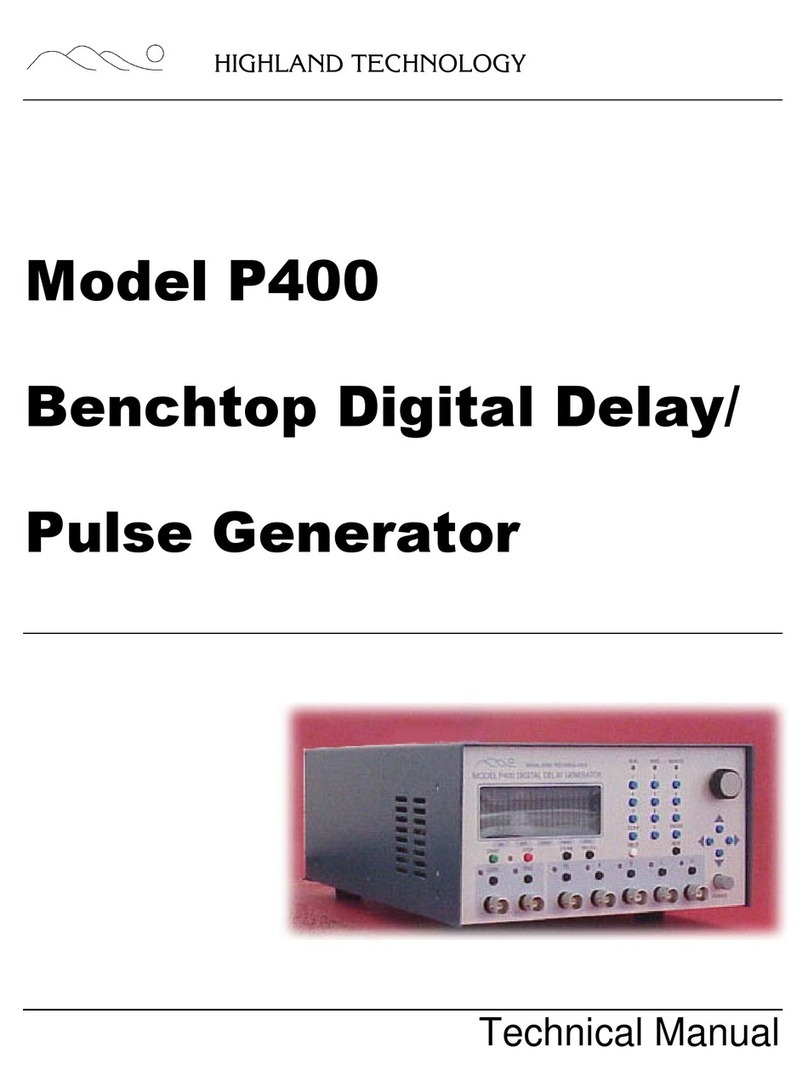
Highland
Highland P400 Technical manual
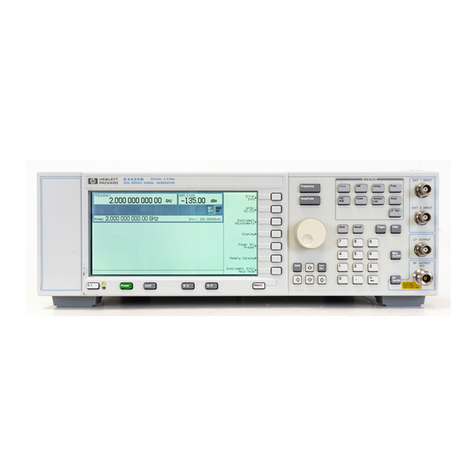
HP
HP ESG E4400B Installation note

Keysight Technologies
Keysight Technologies 15433B user guide

pico Technology
pico Technology PicoSource PG900 Series quick start guide
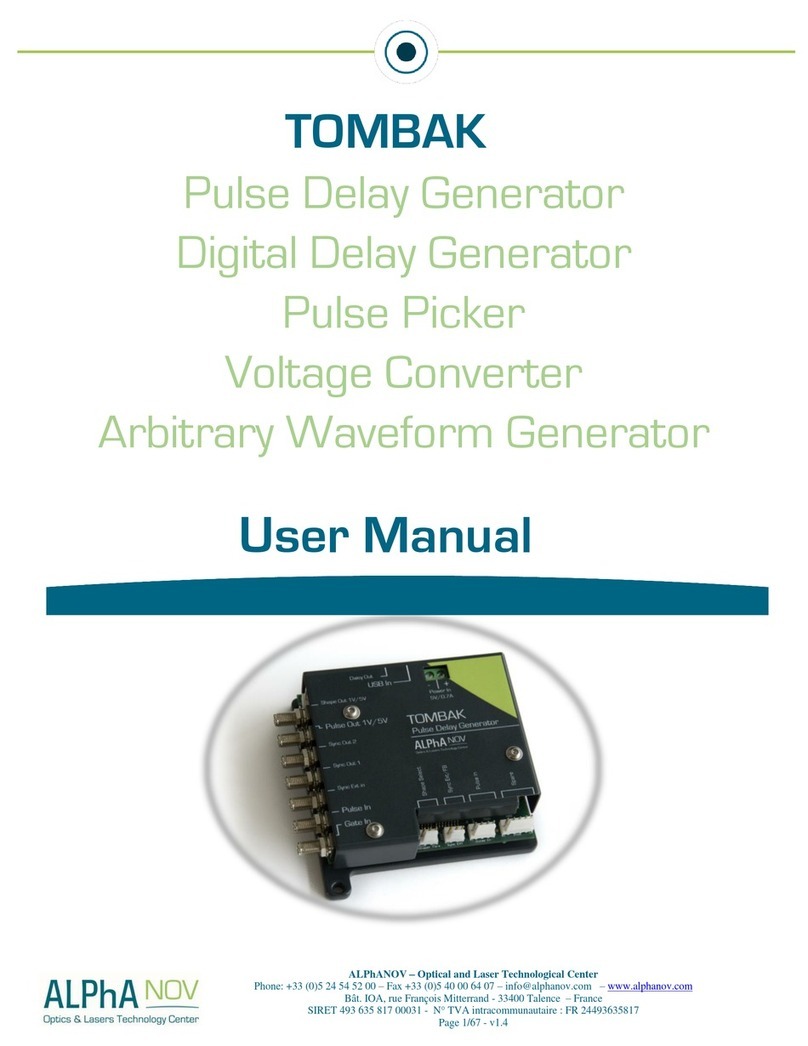
ALPhANOV
ALPhANOV TOMBAK user manual
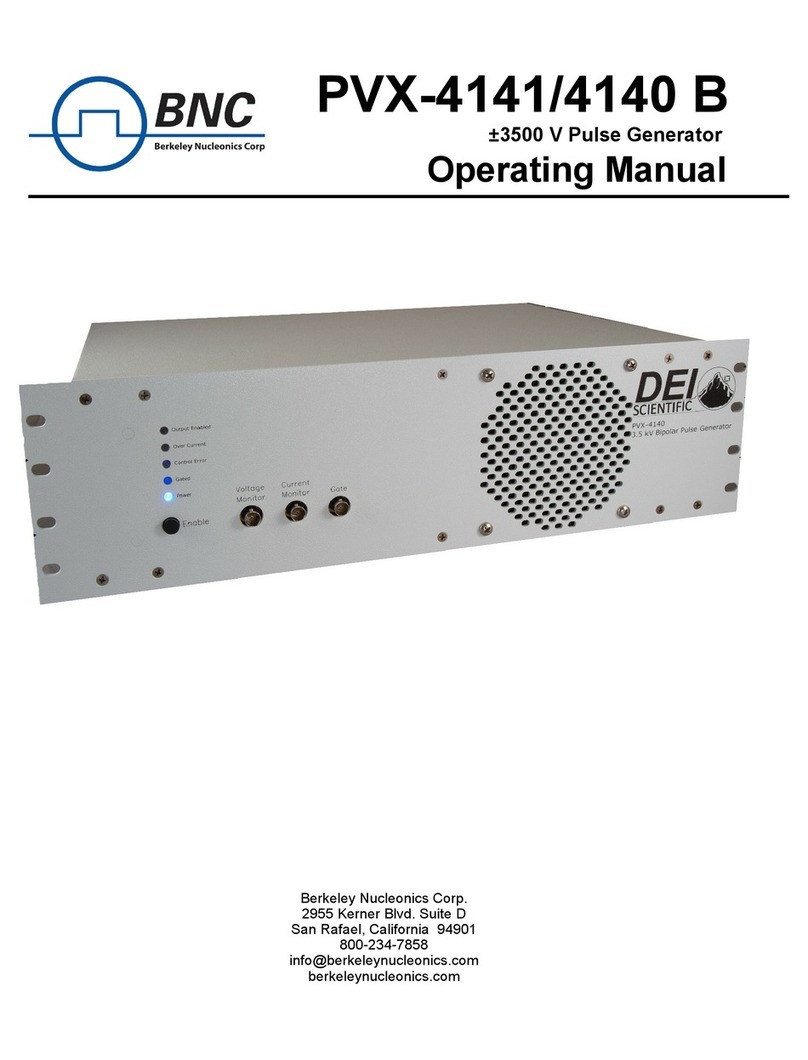
BNC
BNC DEI SCIENTIFIC PVX-4141 B operating manual
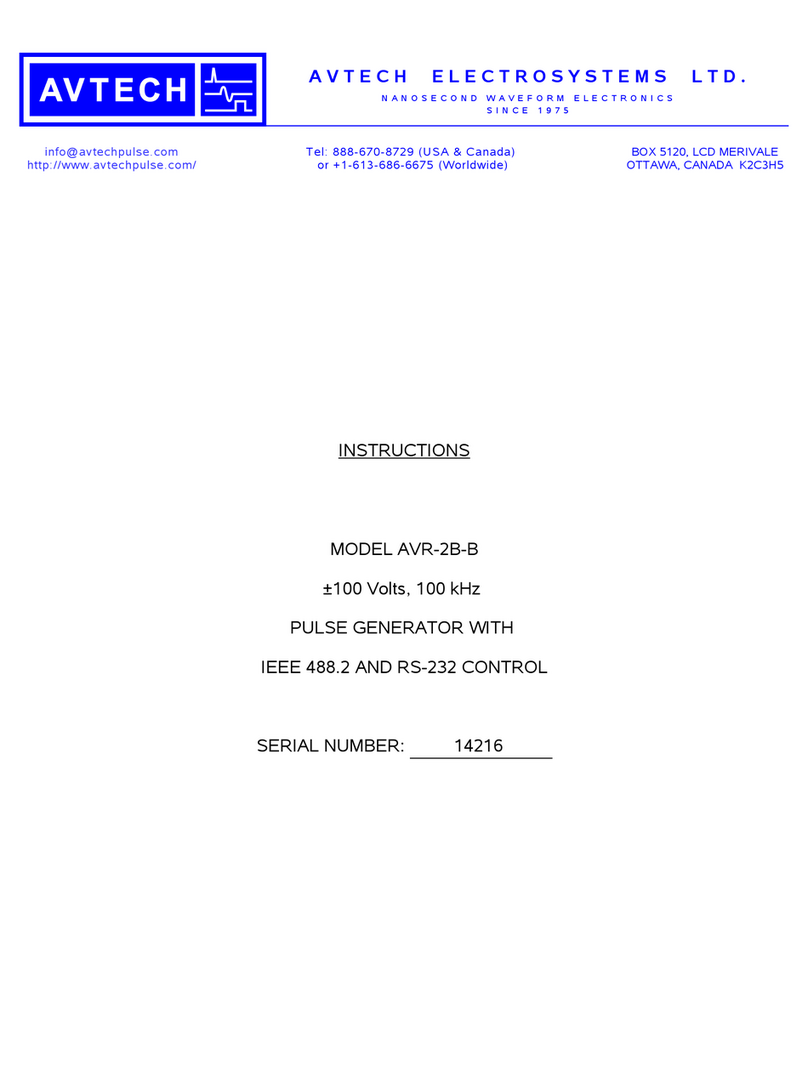
AVTECH ELECTROSYSTEMS LTD.
AVTECH ELECTROSYSTEMS LTD. AVR-2B-B instructions
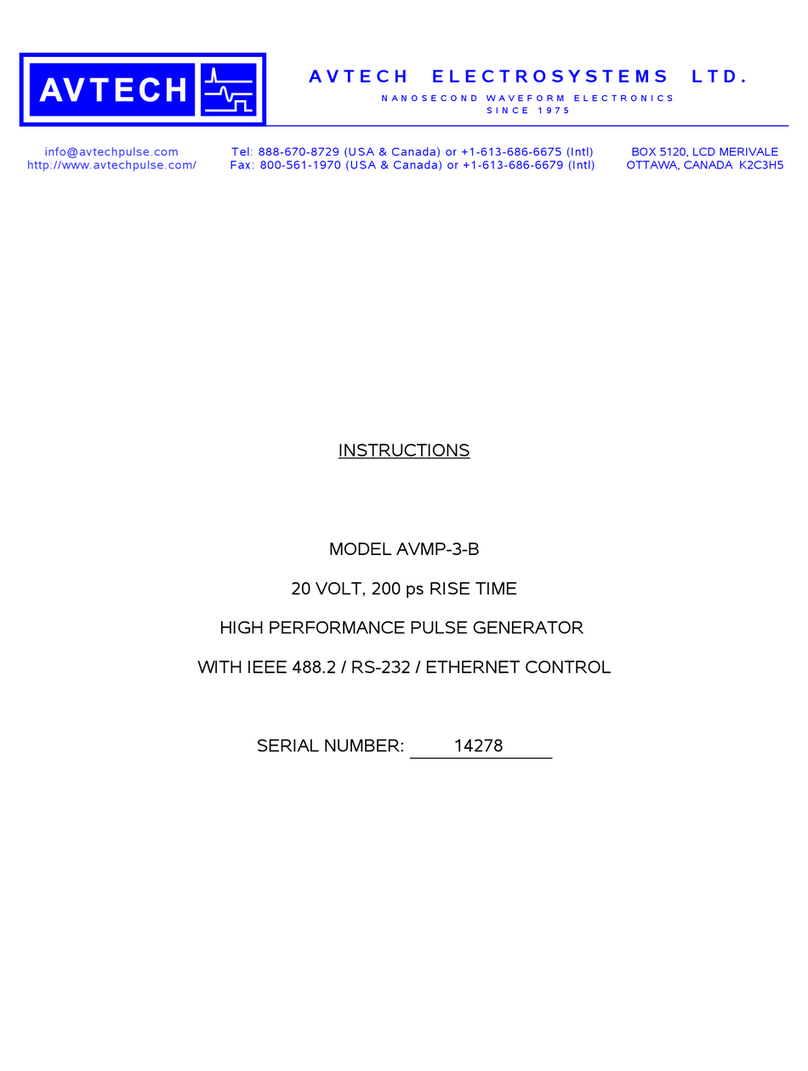
Avtech
Avtech AVMP-3-B instructions
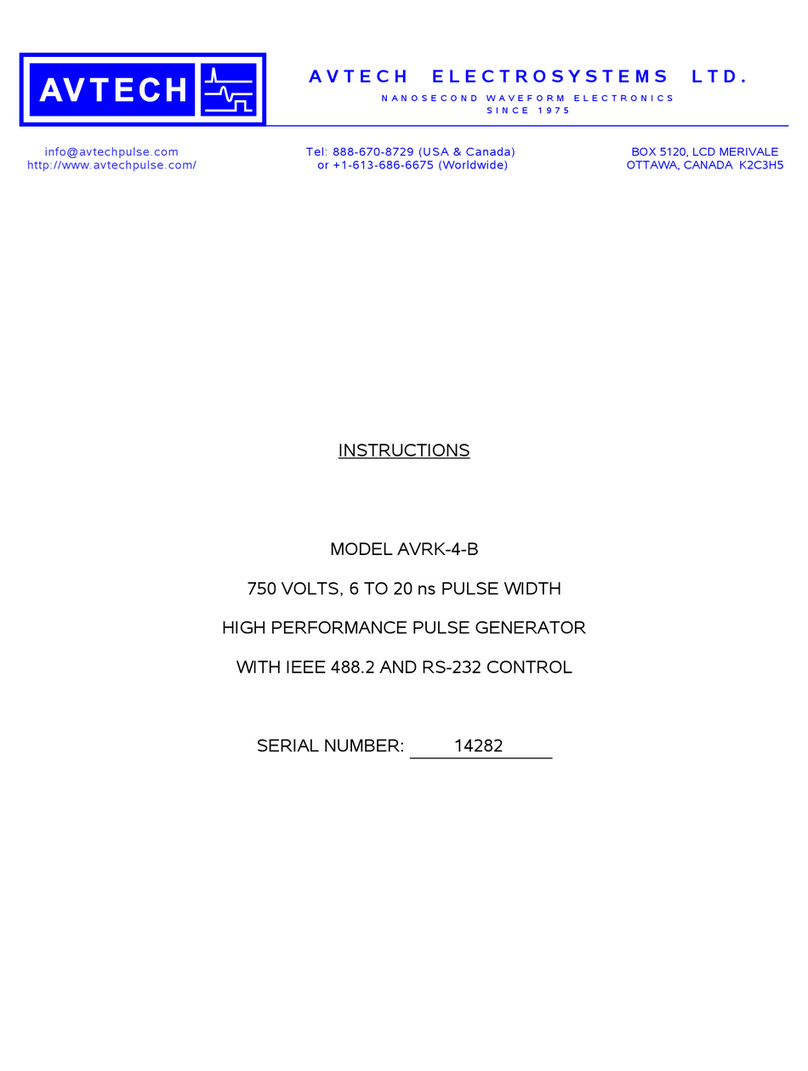
AVTECH ELECTROSYSTEMS LTD.
AVTECH ELECTROSYSTEMS LTD. AVRK-4-B instructions
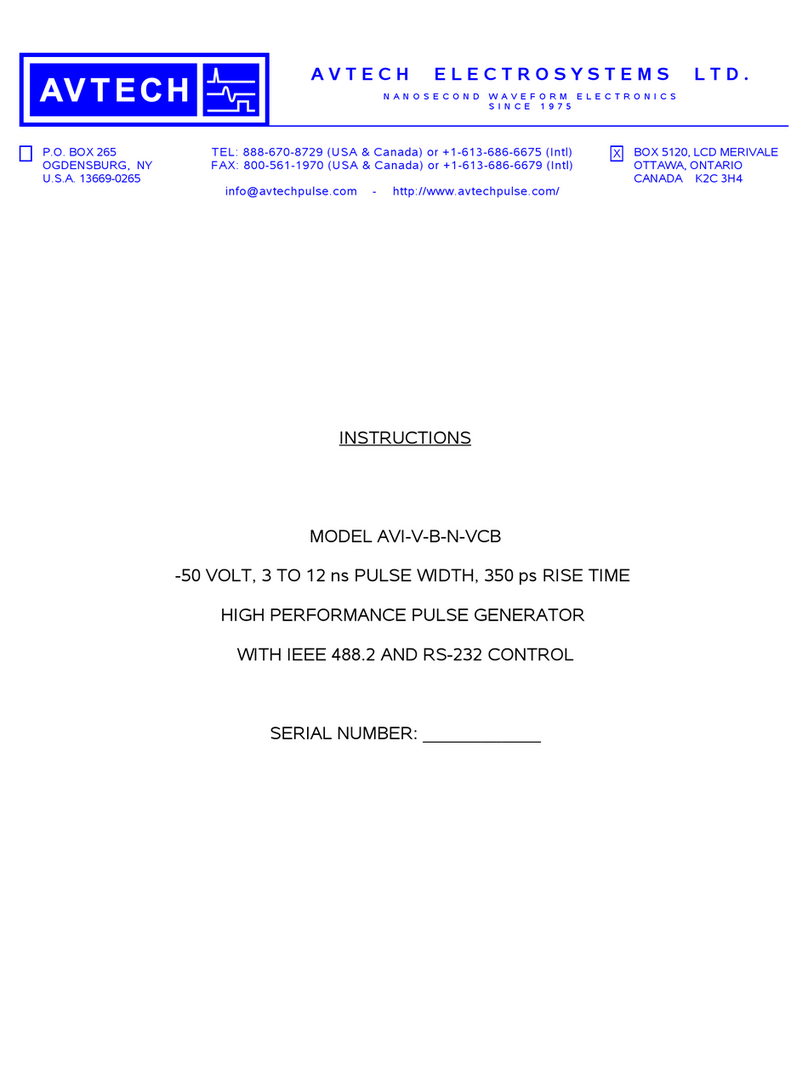
Avtech
Avtech AVI-V-B-N-VCB instructions

Avtech
Avtech AVOZ-H1-B instructions
